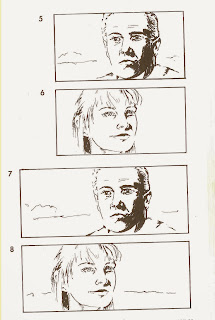Shot Types and their Uses
The storyboard artist needs to be able to convey the message set out in the script. He asks himself 'what is the BUSINESS of this scene?'
When he is satisfied that he knows what the scriptwriter was trying to 'say' he considers the FRAMING of each shot and how best to convey the story.
It is also important that everyone involved with the production speaks the same (filmic) language:
Here are abbreviations for shot types.
There are reasons to use different shot types.
A close up is used to show the audience the facial expression of the character when that is required.

An EXTREME CLOSE UP can be used to point out a single feature of something to the audience, effective but not used too often as is isn't natural to be this close to something.
A MID SHOT is taken from a camera at a medium distance. When depicting a character in mid shots, the subject is shot from the waist upwards. This type of shot clearly shows a character and gives an overall context to the shot/scene. The audience can see the facial expression as well as the BODY LANGUAGE.
A GROUP SHOT can show the dynamics between a group of people and their body language.
A WIDE SHOT shows the audience a character's body language as well as the setting they are in.
To draw the audiences attention to something specific you can indicate a TRACK IN or a TRACK OUT.
If you want the audience to move with the character(s) you can indicate a pan.
Task 1:
Work in pairs to identify shot types and the intended effect.
Submit one printed document with both names on.
Storyboards are the first VISUALISATION of the script, where words become pictures.
They are the blueprint for the film and all the subsequent departments will refer to it benefitting CONTINUITY.
Some storyboards are very detailed but a storyboard artist does not have to be a brilliant draughtsman. It is important though, that the message put down in the script is clearly described visually. This is why we spend so much time on the script.
Some storyboards, such as this from the feature film THE MATRIX, have been so good that they have helped to raise funding to get the film produced.
Comic book artists often make good storyboard artists because they have a good knowledge of things like body language. Thinking in terms of silhouette is always helpful when storyboarding.
This page was drawn by the comic artist WILL EISNER.
An important rule of storyboarding is the 180 degree rule. This is to do with placement of cameras. In animation there aren't actually any cameras but the rule should be followed when storyboarding nonetheless. This stops the audience becoming disorientated.
For example; what would happen if wee cut from camera A to camera F?
Here is a plan view of the TRIANGULAR SET UP:
When designing a sequence consisting of two people having a conversation, the OTS can be effective.
A new line of action can be created when another character enters the scene, the board artist can also cut away to a shot of something else in order to change the line of action.
Look at these different shot types and the placement of the characters; try to figure out what is happening in the scene, don't forget to consider the body language and facial expression.
Setting up shots consisting of three or more people is a bit tricky but the line of action or 180 degree rule should still be considered.
Storyboarding
This scene from Leon The Professional breaks the 180 degree rule. Why?
This scene from Lord of the Rings breaks the 180 degree rule. Why?
These are the storyboard panels you will use for your animation pre production there are spaces for ACTION, DIALOGUE and any other NOTES.
Number all pages (top right)
Number all scenes (Sc:)
Indicate the BG (background number) you should re-use these throughout the film so keep going back over your board.
































